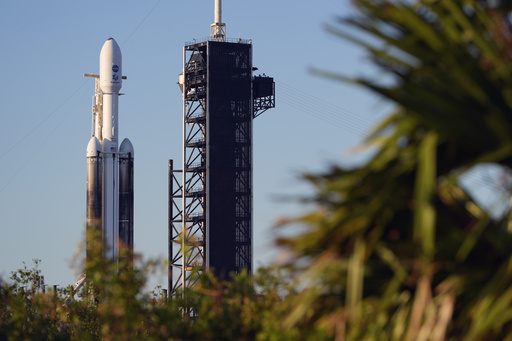
CAPE CANAVERAL, Fla. — A NASA spacecraft departed on a significant journey on Monday, aiming to investigate Europa, one of Jupiter’s intriguing moons, to determine if its vast hidden ocean might harbor the necessary conditions for life.
The Europa Clipper mission is set to take approximately 5 ½ years to reach its destination. Once it arrives at Jupiter, the spacecraft will enter orbit around the gas giant and conduct numerous close flybys of Europa, all while navigating through intense radiation as it explores this fascinating celestial body.
Evidence suggests that beneath Europa’s icy surface lies a deep, global ocean. The presence of water raises the possibility of life, making Europa a prime location for astrobiological research.
However, the Clipper won’t directly search for signs of life, as it lacks life-detection tools. Its primary objective is to identify the essential ingredients for life by looking for organic materials and other indicators as it investigates the conditions beneath the moon’s surface.
“Ocean worlds like Europa are intriguing not just because they may be habitable, but they might actually support life today,” stated Gina DiBraccio from NASA, highlighting the significance of the mission just before launch.
The spacecraft began its ambitious journey of 1.8 million miles (3 billion kilometers) aboard a Falcon Heavy rocket, launched by SpaceX from Kennedy Space Center in Florida.
The $5.2 billion mission faced potential setbacks due to concerns over transistors. NASA discovered in the spring that Clipper’s transistors could be at greater risk from Jupiter’s intense radiation than previously thought. Throughout the upcoming 49 flybys, the spacecraft will experience radiation equivalent to several million chest X-rays. After months of assessment, NASA confirmed in September that the mission could proceed without major adjustments.
Additionally, Hurricane Milton posed challenges that delayed the launch for several days, adding to the tension surrounding the mission.
Roughly the size of a basketball court when fully extended, the Clipper will first maneuver past Mars and then Earth to gain additional speed through gravitational assists. The spacecraft, which weighs nearly 13,000 pounds (5,700 kilograms), is expected to reach Jupiter in 2030.
Once in orbit, it will complete a rotation around Jupiter every 21 days, with one of those orbits bringing it close to Europa, which is one of Jupiter’s 95 known moons and comparable in size to Earth’s moon.
The spacecraft will perform flybys at altitudes as low as 16 miles (25 kilometers) above Europa’s surface, significantly closer than prior missions. It is outfitted with radar designed to penetrate the moon’s ice layer, which may be between 10 miles to over 15 miles (15 kilometers to 24 kilometers) thick. Scientists believe that the ocean beneath could extend to depths of 80 miles (120 kilometers) or more.
Equipped with nine scientific instruments, the spacecraft has its sensitive electronics housed in a protective vault constructed with dense zinc and aluminum, creating a shield against radiation. The exploration mission is set to continue until 2034.
Should Europa reveal conditions conducive to life, it could pave the way for the exploration of other oceanic worlds in our solar system and beyond. Saturn’s moon Enceladus, noted for its underground ocean and geysers, stands out as another prime candidate for potential life.
